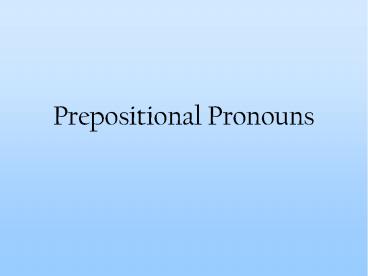Prepositional Pronouns - PowerPoint PPT Presentation
Title:
Prepositional Pronouns
Description:
Prepositional Pronouns So what are prepositional pronouns? They re pronouns that follow prepositions. Unfortunately, these days the next question is What are ... – PowerPoint PPT presentation
Number of Views:197
Avg rating:3.0/5.0
Title: Prepositional Pronouns
1
Prepositional Pronouns
2
- So what are prepositional pronouns? Theyre
pronouns that follow prepositions. - Unfortunately, these days the next question is
What are prepositions? You shouldnt reach
college without knowing what prepositions are. - Unfortunately, many of you have.
3
- Prepositions are words that show the relationship
between other words. - The boy with the gorgeous smile is my brother.
- With shows the relationship between boy and
smile. - He lives in Alaska.
- In shows the relationship between lives and
Alaska.
4
- In English, prepositions are usually, but not
always, short words - of from
- to at
- in near
- for under
- over with
- BUT
- between beneath
- during before
- beside inside
- outside
5
- A large number of Spanish prepositions have de
with them - después de--after antes de--before
- debajo de--under cerca de--near
- al lado de--beside dentro de--inside
- fuera de--outside
- entrebetween conwith
- enin, at, on sobreon, about
- defrom duranteduring
- ato porfor, by
- para--for
6
- In English, direct object pronouns (d.o.),
indirect object pronouns (i.o.), and
prepositional pronouns (p.p.) are all the same - me us
- you yall
- him,her,it them
- d.o. i.o
p.p. - Juan sees me./Juan gave me the rose./Juan lives
near me.
7
- In Spanish, however, there are three different
sets - direct indirect
- me nos me nos
- te os te os
- lo, la los, las le les
- prepositional
- mí nosotros
- ti vosotros
- él, ella, Ud. ellos, Uds.
8
- Lets look at those again
- prepositional
- nosotros
- vosotros
- él, ella, Ud. ellos, Uds.
- They look a little familiar. Thats because,
with the exception of mí and ti, theyre
identical to SUBJECT pronouns - nosotros
- vosotros
- él, ella, Ud. ellos, Uds.
mí
ti
yo
tú
9
- Mí probably also looks a little familiar.
Thats because youve had mi. Remember what it
means? Mymi casa. So the accent mark is
important. It makes the difference between a
prepositional PRONOUN (mí) and a possessive
ADJECTIVE (mi).
10
- Lets see what these pronouns look like in
context - Juan habla con ella.
- Yo compré un libro para ti.
- Elisa vive cerca de mí.
- Esa carta es de nosotros.
11
- So its simple. Whenever you have a preposition
and need a pronoun after it, use one of these - prepositional
- mí nosotros
- ti vosotros
- él, ella, Ud. ellos, Uds.
12
- prepositional subject
- mí nosotros yo nosotros
- ti vosotros tú vosotros
- él, ella, Ud. ellos, Uds. él, ella, Ud. ellos,
Uds. - direct object indirect object
- me nos me nos
- te os te os
- lo, la los, las le les
- reflexive possessive
ADJECTIVES - me nos mi nuestro
- te os tu vuestro
- se se su su
13
- Click here to go to your homework exercise.
- Below are links to other pronoun lessons
- Direct objects
- Indirect objects
- Reflexive
- Subject
- Possessive ADJECTIVES































